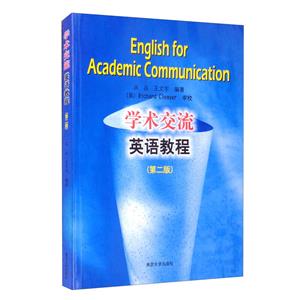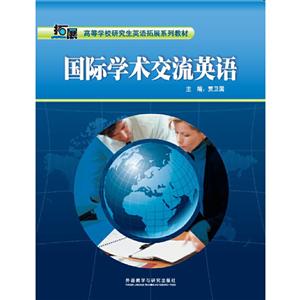
作者:李文梅
页数:269
出版社:清华大学出版社
出版日期:2021
ISBN:9787302586104
电子书格式:pdf/epub/txt
内容简介
《研究生学术交流英语》全面覆盖研究生主要学术活动,包括:学术英语的内涵和特征;学术英语问题自我诊断及解决途径;文献获取、文献管理和文献综述的工具和方法;如何聆听学术报告;如何辨析国际会议信息;如何开展学术目的的英语通信和交谈;如何进行学术会议报告;如何进行学术目的的英语提问与回答;如何用英语主持学术会议;师生如何共建模拟国际学术大会等。每个单元由教学目标、课前问题、学术英语困难情景、翻转课堂、对分课堂、课后反思与实践、语言工具箱构成,实现了课前、课中和课后无缝衔接。 《研究生学术交流英语》可作为高等学校硕士生和博士生英语教材,也可供其他需要提高英语学术交流能力的人员使用。
作者简介
李文梅,女,副教授,硕导,从教28年积累了丰富的教学经验。2004年入选江苏省“青蓝工程”优秀青年骨干教师;2009年获江苏省高等学校青年教师英语授课一等奖;2012-2014年任中国矿业大学督导组专家;曾获得中国矿业大学“最受欢迎的基础课教师”、百佳教师、师德模范、教书育人标兵、徐州市劳动模范、徐州市教书育人先进个人等荣誉称号;多次获得中国矿业大学优秀教学质量一等奖、优秀教学成果一等奖。
本书特色
《研究生学术交流英语》主要特色: 目标明确 提升学术交流综合素养实用能力 内容全面 涵盖国际学术交流主场景全过程 设计新颖 契合学术发展之旅,多模块化递进 理念先进 兼顾各学科,产出驱动式立体交互
目录
Part One Approaching Academic English
UNIT 1 Getting Acquainted with Academic English…… 3
1.1 Overall Impression of Academic English…………………………….4
1.1.1 A Glance over Written Academic English……………………..5
1.1.2 A Glimpse of Spoken Academic English……………………….7
1.2 Salient Features of Academic English……………………………….10
1.2.1 Vocabulary………………………………………………………………10
1.2.2 Hedging…………………………………………………………………..12
1.3 Differentiating Academic English & General English………..15
1.3.1 Main Features of Spoken Academic English………………..16
1.3.2 Main Features of Written Academic English………………..20
UNIT 2 Cultivating Academic English Competencies….. 23
2.1 Diagnosing Your Academic English Language Competencies….24
2.1.1 Identifying General Problems with Your Academic
English Communication…………………………………………….25
2.1.2 Understanding Specific Academic English
Communication Language Abilities Scales………………….28
2.1.3 Locating the Gap Between Your Language Abilities and
the Standards……………………………………………………………32
2.2 Ways to Improve Academic Communication Competencies….34
2.2.1 Improving Academic Communication Language Abilities….34
2.2.2 Enhancing Academic English Non-language Abilities…..38
2.2.3 Grasping Essential Skills for Communication in the
Main Oral Academic Scenarios………………………………….39
Part Two Stepping into Academia
UNIT 3 Accessing Academic English Literature……….. 45
3.1 Literature Sources and Types…………………………………………..46
3.1.1 Literature Sources…………………………………………………….47
3.1.2 Major Literature Types………………………………………………49
3.2 Retrieval Databases, Methods and Strategies……………………51
3.2.1 Retrieval Databases…………………………………………………..51
3.2.2 Search Terms for Retrieval………………………………………..54
3.2.3 Retrieving Methods…………………………………………………..56
3.2.4 Retrieving Strategies…………………………………………………59
3.3 Tracking and Ordering Literature……………………………………61
3.3.1 Literature Tracking and Ordering Tools……………………….62
3.3.2 Challenges and Precautions……………………………………….64
UNIT 4 Managing Academic English Literature………. 67
4.1 Reference Management Tools…………………………………………..68
4.1.1 Some English Literature Management Tools………………..68
4.1.2 Main Features of English Literature Management Tools….69
4.2 Principles and Steps to Manage Academic English Documents….71
4.2.1 Following Some Principles to Manage Documents……….71
4.2.2 Managing Documents in Pre-reading………………………….72
4.2.3 Managing Documents in Preliminary Reading……………..73
4.2.4 Managing Documents in In-depth Reading………………….73
4.2.5 Managing Documents in Writing………………………………..74
4.2.6 Important Tips for Literature Management…………………..75
UNIT 5 Reviewing Academic English Literature……… 79
5.1 Selecting Sources……………………………………………………………..80
5.1.1 Reviewing Literature………………………………………………..81
5.1.2 Evaluating Sources……………………………………………………84
5.2 Structuring a Literature Review………………………………………89
5.2.1 Contents of a Literature Review…………………………………89
5.2.2 Ways of Grouping a Literature Review……………………….92
5.3 Citing Sources………………………………………………………………….94
5.3.1 Plagiarism……………………………………………………………….95
5.3.2 Summarizing, Paraphrasing and Direct Quotation………..96
5.4 Following Academic Conventions in Referencing…………….101
5.4.1 Styles of Referencing………………………………………………101
5.4.2 Verbs of Referencing……………………………………………….103
Part Three Basic Academic English Communication
UNIT 6 Sitting in English Academic Lectures………… 109
6.1 Be Active Listeners…………………………………………………………110
6.1.1 What Is Special of an Academic Lecture?………………….111
6.1.2 Focusing on Language Use Strategy in Lectures…………112
6.1.3 Taking Notes………………………………………………………….114
6.1.4 Identifying Topic Sentences……………………………………..117
6.2 Evaluating While Listening…………………………………………….120
6.3 Raising Questions for Further Understanding…………………125
6.3.1 Functions of Asking Questions…………………………………125
6.3.2 Purposes of Asking Questions………………………………….127
UNIT 7 Asking and Answering Academic Questions…. 131
7.1 Understanding Questions……………………………………………….132
7.1.1 Reasons for Asking Questions………………………………….133
7.1.2 Questioning in Q&A Session……………………………………133
7.2 Asking Questions……………………………………………………………136
7.2.1 Template of Asking a Question…………………………………136
7.2.2 Types of Questions………………………………………………….138
7.3 Answering Questions……………………………………………………..142
7.3.1 General Skills for Answering Questions…………………….143
7.3.2 Direct Answers……………………………………………………….145
7.3.3 Avoidance………………………………………………………………147
UNIT 8 Corresponding for Academic Purposes……… 155
8.1 Introduction of Academic Correspondence……………………..156
8.1.1 Definition of Academic Correspondence……………………156
8.1.2 Various Purposes of English Academic Correspondence….157
8.2 Features of English Academic Correspondence……………….160
8.2.1 Formats of Academic Correspondence………………………160
8.2.2 Language Features of Academic Correspondence……….164
8.3 Writing Strategies in Academic Correspondence…………….166
8.3.1 Use You-attitude Rather Than I-attitude…………………….166
8.3.2 More Communicative Strategies in Correspondence…..167
Part Four Advanced Academic English Communication
Identifying International Conference
UNIT 9 Information……………………………………………… 179
9.1 Benefits of Attending International Academic Conferences….180
9.2 Information Sources on International Academic Conferences….185
9.3 Varieties of Academic Conferences………………………………….187
9.4 Conference Information and Major Conference Activities…..192
9.4.1 Conference Information…………………………………………..193
9.4.2 Major Conference Activities…………………………………….195
UNIT 10 Making a Paper Presentation…………………. 199
10.1 Structuring a Presentation………………………………………..200
10.1.1 Opening………………………………………………………….201
10.1.2 Main Body……………………………………………………..204
10.1.3 Ending……………………………………………………………205
10.2 Preparing a Presentation…………………………………………..208
10.2.1 Preparation Procedure………………………………………209
10.2.2 PowerPoint Design………………………………………….212
10.3 Delivering a Presentation………………………………………….215
10.3.1 Presentation Skills……………………………………………215
10.3.2 Verbal Expressions…………………………………………..218
UNIT 11 Initiating Free Exchanges with Academics…. 225
11.1 Preparing a Talk with Professionals…………………………..226
11.1.1 Topic Choosing……………………………………………….227
11.1.2 Information Collecting……………………………………..227
11.1.3 Idea Organizing and Outlining…………………………..228
11.2 Starting a Talk with Professionals……………………………..230
11.2.1 Talking with Familiar Professionals…………………..230
11.2.2 Talking with Strangers……………………………………..231
11.3 Deepening the Topic………………………………………………….231
11.4 Shifting the Topic……………………………………………………..233
UNIT 12 Presiding over a Session…………………………. 235
12.1 Preparations Before the Session………………………………..236
12.2 Making an Opening Speech and Introducing a Speaker….239
12.2.1 Making an Opening Speech………………………………240
12.2.2 Introducing a Speaker………………………………………241
12.3 Q&A Sessions and Thank-You Speeches……………………244
Co-constructing a Simulated International
UNIT 13 Conference…………………………………………….. 251
13.1 The Significance of Co-constructing a Simulated
International
Conference………………………………………….252
13.1.1 Distinguishing the Varieties of International
Conferences……………………………………………………253
13.1.2 Mastering the Whole Procedures of International
Conferences……………………………………………………254
13.2 Major Sessions of Simulated International Conferences…..255
13.2.1 Organization of an International Conference……….256
13.2.2 Routine Work of Organizing an International
Conference……………………………………………………..256
13.3 How to Co-construct a Simulated International Conference…..257
13.3.1 To-do list at the Very Beginning of a Simulated
International Conference…………………………………..258
13.3.2 Promoting a Simulated International Conference…..259
13.3.3 Calling for Paper of a Simulated International
Conference……………………………………………………..261
13.3.4 Invitation Letter of a Simulated International
Conference……………………………………………………..262
13.3.5 Agenda of a Simulated International Conference…..262
13.4 The Evaluation of a Simulated International Conference…..264
References……………………………………………………………………… 267_x00C_
UNIT 1 Getting Acquainted with Academic English…… 3
1.1 Overall Impression of Academic English…………………………….4
1.1.1 A Glance over Written Academic English……………………..5
1.1.2 A Glimpse of Spoken Academic English……………………….7
1.2 Salient Features of Academic English……………………………….10
1.2.1 Vocabulary………………………………………………………………10
1.2.2 Hedging…………………………………………………………………..12
1.3 Differentiating Academic English & General English………..15
1.3.1 Main Features of Spoken Academic English………………..16
1.3.2 Main Features of Written Academic English………………..20
UNIT 2 Cultivating Academic English Competencies….. 23
2.1 Diagnosing Your Academic English Language Competencies….24
2.1.1 Identifying General Problems with Your Academic
English Communication…………………………………………….25
2.1.2 Understanding Specific Academic English
Communication Language Abilities Scales………………….28
2.1.3 Locating the Gap Between Your Language Abilities and
the Standards……………………………………………………………32
2.2 Ways to Improve Academic Communication Competencies….34
2.2.1 Improving Academic Communication Language Abilities….34
2.2.2 Enhancing Academic English Non-language Abilities…..38
2.2.3 Grasping Essential Skills for Communication in the
Main Oral Academic Scenarios………………………………….39
Part Two Stepping into Academia
UNIT 3 Accessing Academic English Literature……….. 45
3.1 Literature Sources and Types…………………………………………..46
3.1.1 Literature Sources…………………………………………………….47
3.1.2 Major Literature Types………………………………………………49
3.2 Retrieval Databases, Methods and Strategies……………………51
3.2.1 Retrieval Databases…………………………………………………..51
3.2.2 Search Terms for Retrieval………………………………………..54
3.2.3 Retrieving Methods…………………………………………………..56
3.2.4 Retrieving Strategies…………………………………………………59
3.3 Tracking and Ordering Literature……………………………………61
3.3.1 Literature Tracking and Ordering Tools……………………….62
3.3.2 Challenges and Precautions……………………………………….64
UNIT 4 Managing Academic English Literature………. 67
4.1 Reference Management Tools…………………………………………..68
4.1.1 Some English Literature Management Tools………………..68
4.1.2 Main Features of English Literature Management Tools….69
4.2 Principles and Steps to Manage Academic English Documents….71
4.2.1 Following Some Principles to Manage Documents……….71
4.2.2 Managing Documents in Pre-reading………………………….72
4.2.3 Managing Documents in Preliminary Reading……………..73
4.2.4 Managing Documents in In-depth Reading………………….73
4.2.5 Managing Documents in Writing………………………………..74
4.2.6 Important Tips for Literature Management…………………..75
UNIT 5 Reviewing Academic English Literature……… 79
5.1 Selecting Sources……………………………………………………………..80
5.1.1 Reviewing Literature………………………………………………..81
5.1.2 Evaluating Sources……………………………………………………84
5.2 Structuring a Literature Review………………………………………89
5.2.1 Contents of a Literature Review…………………………………89
5.2.2 Ways of Grouping a Literature Review……………………….92
5.3 Citing Sources………………………………………………………………….94
5.3.1 Plagiarism……………………………………………………………….95
5.3.2 Summarizing, Paraphrasing and Direct Quotation………..96
5.4 Following Academic Conventions in Referencing…………….101
5.4.1 Styles of Referencing………………………………………………101
5.4.2 Verbs of Referencing……………………………………………….103
Part Three Basic Academic English Communication
UNIT 6 Sitting in English Academic Lectures………… 109
6.1 Be Active Listeners…………………………………………………………110
6.1.1 What Is Special of an Academic Lecture?………………….111
6.1.2 Focusing on Language Use Strategy in Lectures…………112
6.1.3 Taking Notes………………………………………………………….114
6.1.4 Identifying Topic Sentences……………………………………..117
6.2 Evaluating While Listening…………………………………………….120
6.3 Raising Questions for Further Understanding…………………125
6.3.1 Functions of Asking Questions…………………………………125
6.3.2 Purposes of Asking Questions………………………………….127
UNIT 7 Asking and Answering Academic Questions…. 131
7.1 Understanding Questions……………………………………………….132
7.1.1 Reasons for Asking Questions………………………………….133
7.1.2 Questioning in Q&A Session……………………………………133
7.2 Asking Questions……………………………………………………………136
7.2.1 Template of Asking a Question…………………………………136
7.2.2 Types of Questions………………………………………………….138
7.3 Answering Questions……………………………………………………..142
7.3.1 General Skills for Answering Questions…………………….143
7.3.2 Direct Answers……………………………………………………….145
7.3.3 Avoidance………………………………………………………………147
UNIT 8 Corresponding for Academic Purposes……… 155
8.1 Introduction of Academic Correspondence……………………..156
8.1.1 Definition of Academic Correspondence……………………156
8.1.2 Various Purposes of English Academic Correspondence….157
8.2 Features of English Academic Correspondence……………….160
8.2.1 Formats of Academic Correspondence………………………160
8.2.2 Language Features of Academic Correspondence……….164
8.3 Writing Strategies in Academic Correspondence…………….166
8.3.1 Use You-attitude Rather Than I-attitude…………………….166
8.3.2 More Communicative Strategies in Correspondence…..167
Part Four Advanced Academic English Communication
Identifying International Conference
UNIT 9 Information……………………………………………… 179
9.1 Benefits of Attending International Academic Conferences….180
9.2 Information Sources on International Academic Conferences….185
9.3 Varieties of Academic Conferences………………………………….187
9.4 Conference Information and Major Conference Activities…..192
9.4.1 Conference Information…………………………………………..193
9.4.2 Major Conference Activities…………………………………….195
UNIT 10 Making a Paper Presentation…………………. 199
10.1 Structuring a Presentation………………………………………..200
10.1.1 Opening………………………………………………………….201
10.1.2 Main Body……………………………………………………..204
10.1.3 Ending……………………………………………………………205
10.2 Preparing a Presentation…………………………………………..208
10.2.1 Preparation Procedure………………………………………209
10.2.2 PowerPoint Design………………………………………….212
10.3 Delivering a Presentation………………………………………….215
10.3.1 Presentation Skills……………………………………………215
10.3.2 Verbal Expressions…………………………………………..218
UNIT 11 Initiating Free Exchanges with Academics…. 225
11.1 Preparing a Talk with Professionals…………………………..226
11.1.1 Topic Choosing……………………………………………….227
11.1.2 Information Collecting……………………………………..227
11.1.3 Idea Organizing and Outlining…………………………..228
11.2 Starting a Talk with Professionals……………………………..230
11.2.1 Talking with Familiar Professionals…………………..230
11.2.2 Talking with Strangers……………………………………..231
11.3 Deepening the Topic………………………………………………….231
11.4 Shifting the Topic……………………………………………………..233
UNIT 12 Presiding over a Session…………………………. 235
12.1 Preparations Before the Session………………………………..236
12.2 Making an Opening Speech and Introducing a Speaker….239
12.2.1 Making an Opening Speech………………………………240
12.2.2 Introducing a Speaker………………………………………241
12.3 Q&A Sessions and Thank-You Speeches……………………244
Co-constructing a Simulated International
UNIT 13 Conference…………………………………………….. 251
13.1 The Significance of Co-constructing a Simulated
International
Conference………………………………………….252
13.1.1 Distinguishing the Varieties of International
Conferences……………………………………………………253
13.1.2 Mastering the Whole Procedures of International
Conferences……………………………………………………254
13.2 Major Sessions of Simulated International Conferences…..255
13.2.1 Organization of an International Conference……….256
13.2.2 Routine Work of Organizing an International
Conference……………………………………………………..256
13.3 How to Co-construct a Simulated International Conference…..257
13.3.1 To-do list at the Very Beginning of a Simulated
International Conference…………………………………..258
13.3.2 Promoting a Simulated International Conference…..259
13.3.3 Calling for Paper of a Simulated International
Conference……………………………………………………..261
13.3.4 Invitation Letter of a Simulated International
Conference……………………………………………………..262
13.3.5 Agenda of a Simulated International Conference…..262
13.4 The Evaluation of a Simulated International Conference…..264
References……………………………………………………………………… 267_x00C_















